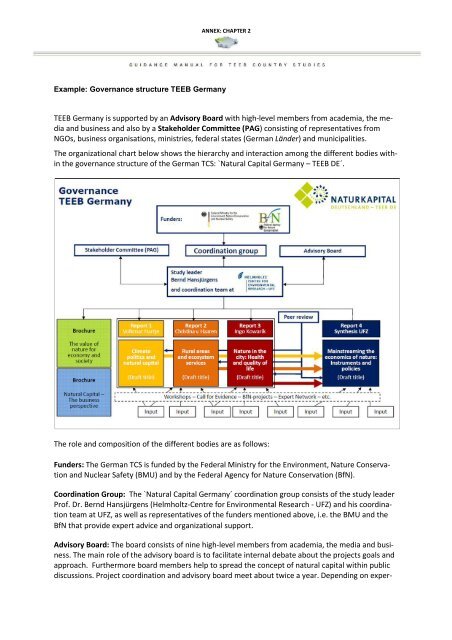Example: Governance structure TEEB Germany
Example: Governance structure TEEB Germany
Example: Governance structure TEEB Germany
You also want an ePaper? Increase the reach of your titles
YUMPU automatically turns print PDFs into web optimized ePapers that Google loves.
ANNEX: CHAPTER 2<br />
<strong>Example</strong>: <strong>Governance</strong> <strong>structure</strong> <strong>TEEB</strong> <strong>Germany</strong><br />
<strong>TEEB</strong> <strong>Germany</strong> is supported by an Advisory Board with high-level members from academia, the media<br />
and business and also by a Stakeholder Committee (PAG) consisting of representatives from<br />
NGOs, business organisations, ministries, federal states (German Länder) and municipalities.<br />
The organizational chart below shows the hierarchy and interaction among the different bodies within<br />
the governance <strong>structure</strong> of the German TCS: `Natural Capital <strong>Germany</strong> – <strong>TEEB</strong> DE´.<br />
The role and composition of the different bodies are as follows:<br />
Funders: The German TCS is funded by the Federal Ministry for the Environment, Nature Conservation<br />
and Nuclear Safety (BMU) and by the Federal Agency for Nature Conservation (BfN).<br />
Coordination Group: The `Natural Capital <strong>Germany</strong>´ coordination group consists of the study leader<br />
Prof. Dr. Bernd Hansjürgens (Helmholtz-Centre for Environmental Research - UFZ) and his coordination<br />
team at UFZ, as well as representatives of the funders mentioned above, i.e. the BMU and the<br />
BfN that provide expert advice and organizational support.<br />
Advisory Board: The board consists of nine high-level members from academia, the media and business.<br />
The main role of the advisory board is to facilitate internal debate about the projects goals and<br />
approach. Furthermore board members help to spread the concept of natural capital within public<br />
discussions. Project coordination and advisory board meet about twice a year. Depending on exper-
ANNEX: CHAPTER 2<br />
tise and interest, the board members are invited to participate in reviewing the various thematic<br />
reports.<br />
Project Advisory Group (PAG) or Stakeholder Committee: Among the members of the PAG are representatives<br />
of federal ministries, state level governments and municipalities as well as nongovernmental<br />
environmental organizations and business organizations. The main intention of the<br />
PAG is to set up a network of stakeholders in the most affected sectors and policy fields, to inform<br />
them about the aims and findings of the project as well as to consider their views and expertise in<br />
analyzing the importance of biodiversity and ecosystem services for human well-being and economic<br />
development. Project coordination group and the stakeholder committee meet about once a year.<br />
The (relevant) members of the PAG are invited to participate in workshops and reviews related to the<br />
production of the various thematic reports.<br />
Report Leadership: The four different thematic reports of `Natural Capital <strong>Germany</strong> – <strong>TEEB</strong> DE´ are<br />
coordinated by independent report leaders from academia. For further details on the thematic focus<br />
of the <strong>TEEB</strong>-<strong>Germany</strong> reports please see Box 2.6 in the Guidance Manual for <strong>TEEB</strong> Country Studies.

















